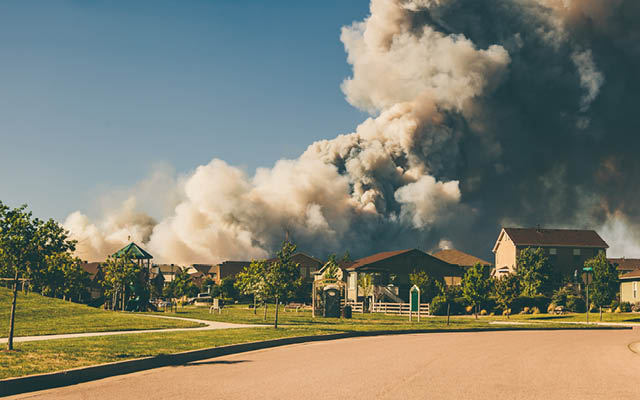As much as I’ve come to accept that life as a septuagenarian is a bit of a crapshoot, what with random cellular mischief occasionally complicating basic bodily functions, there are moments when my cautious optimism can’t help but descend into murky fatalism. Last week, for instance, I stumbled upon a raft of new research suggesting that all the health-affirming habits I’ve established over the years may be undone by a force over which I have very little control: the air I breathe.
We’ve known for decades what air pollution can do to the lungs, and more-recent research has revealed its harmful effects on the cardiovascular system. But fresh revelations are particularly noteworthy — and disturbing — for older adults. They link poor-quality air to a higher risk of Parkinson’s disease, late-life depression, and dementia.
In a paper to be presented at the American Academy of Neurology’s annual meeting in April, lead study author Brittany Krzyzanowski, PhD, a post-doctoral researcher at the Barrow Neurological Institute, and her team identified 83,674 seniors diagnosed with Parkinson’s in 2009 among more than 22.5 million Medicare beneficiaries involved in the study. When they plotted the addresses of all participants on a map showing average air pollution exposure levels, and they adjusted for a variety of health and lifestyle factors, the team found that those living in places with the highest exposure to fine particulate matter were 25 percent more likely to develop Parkinson’s than those living in the lowest exposure areas.
“By mapping nationwide levels of Parkinson’s disease and linking them to air pollution,” Krzyzanowski explains, “we hope to create a greater understanding of the regional risks and inspire leaders to take steps to lower risk of disease by reducing levels of air pollution.”
“By mapping nationwide levels of Parkinson’s disease and linking them to air pollution,” Krzyzanowski explains, “we hope to create a greater understanding of the regional risks and inspire leaders to take steps to lower risk of disease by reducing levels of air pollution.”
Xinye Qiu, PhD, of the Harvard T. H. Chan School of Public Health, and Liuhua Shi, ScD, of Emory University, took a similar approach in a study published recently in JAMA. Their team of researchers mapped the addresses of more than 1.5 million Medicare enrollees who were diagnosed with late-onset depression between 2005 and 2016. They found that long-term exposure to fine particulate matter, nitrogen dioxide, and ozone increased the risk of developing the condition — even when pollution levels were lower than government-regulated mandates.
It’s been nearly 10 years since researchers first suggested a link between cognitive dysfunction and air quality, but two recent studies offer both some validation of those earlier findings as well as some promise of mitigation. A January 2022 report, published in Proceedings of the National Academy of Sciences, noted a significant reduction of dementia risk among older women living in areas where levels of nitrogen dioxide and fine particulate matter had dissipated over a 10-year period. And a second study, published in the February 2022 issue of PLOS Medicine, corroborated those findings, noting that lower levels of pollutants resulted in a slower rate of cognitive decline among study participants.
As Judith Graham reports in Kaiser Health News, older adults are particularly vulnerable to fine particulate matter, which can migrate from the nasal cavities to the lungs and brain, triggering inflammation and exacerbating chronic conditions such as heart disease and respiratory illnesses. Graham cites the work of University of Southern California neurobiologist Caleb Finch, PhD, whose research team is embarking on a five-year study to dig deeper into the threat air pollution presents to the aging brain and determine how to most effectively respond.
“The main point is we now realize that Alzheimer’s disease is very sensitive to environmental effects, including air pollution,” Finch says.
“The main point is we now realize that Alzheimer’s disease is very sensitive to environmental effects, including air pollution,” Finch says.
That’s a view shared by The Lancet’s Commission on Dementia Prevention, Intervention, and Care, which in 2020 listed air pollution as one of the risk factors for dementia. Addressing these risks could prevent or delay as many as 40 percent of global dementia cases, the commission notes.
And while air quality has steadily improved over the years — average U.S. annual levels of fine particulate matter, for instance, dropped by 43 percent between 2000 and 2019 — research suggests that seniors remain particularly vulnerable. “With older adults, there really is no level at which air pollution is safe,” argues Jennifer Ailshire, PhD, an associate professor of gerontology and sociology at the University of Southern California.
Ailshire says she’s “hopeful” that air quality continues to improve, but she cautions seniors to check pollution levels before embarking on any outdoor activities. “If it’s a high-risk day,” she warns, “that might not be the day to go out and do heavy yardwork.”
There’s about three feet of snow obstructing my carriage walk after snowplows yesterday cleared our side of the street. Shoveling that out was on my to-do list today, so I checked the weather app on my phone and learned that the quality of the air outside was only moderately risky. That seems to generally align with life in my eighth decade, so I guess I’ll grab my shovel and take my chances.




